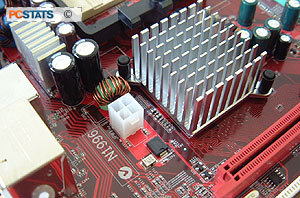 Overclocking the Athlon64 3200+ on the MSI K8T Neo-FIS2R is very much like
overclocking a Pentium 4 processor now that AMD has multiplier locked the processor. It may take
a while for a seasoned pro to get use to the new process.
Overclocking the Athlon64 3200+ on the MSI K8T Neo-FIS2R is very much like
overclocking a Pentium 4 processor now that AMD has multiplier locked the processor. It may take
a while for a seasoned pro to get use to the new process.
Now don't get too upset about AMD locking multipliers, if
I were them I'd do the exact same thing. I believe it was the fake/modified AthlonXP's selling
for inflated prices that prompted this move.... but don't quote me on that.
Anyway getting back to the fun stuff, because the memory
controller and clock generator are built into the core of the Athlon64 3200+ processor,
overclocking the processor can be a lot more tricky as memory controllers tend
to max out very quickly. Also, not much is known about the integrated clock
generator and about how high it can go.
Using the stock AVC HSF we started to raise the clock speed of the entire
motherboard.
At around 210 MHz 'FSB'
we ran into a few stability problems but raising the memory voltage to 2.8V fixed that.
At 221 MHz 'FSB' we again ran into memory related issues and
had to run the memory at 6:5 memory divider (DDR333 mode).
We were a bit surprised that the Corsair XMS3500
CAS2 DIMM's maxed out so quickly as they easily ran at 225-230 MHz 'FSB' in dual
channel mode with the most aggressive timings on an nForce2 based motherboard.
Perhaps the Athlon64's integrated memory controller was starting to max out?
With the
6:5 memory divider enabled we seemed to hit a wall at 223
MHz FSB. No matter what we tried we couldn't get the Athlon64 3200+ processor to run
any faster. Another interesting aspect of trying to figure out the sweet
spots of a new processor; no matter what the Vcore was set to, the voltage the
processor received stayed at 1.5V. I'm not sure what the explanation for this
is, but I'm sure the
situation for enthusiasts will be clearer in the upcoming weeks.
On a side note, I found myself
reading the K8T Neo-FIS2R's manual because the Athlon64 and accompanying
peripherals are so new, so thankfully MSI did a good job describing every
little trivial thing.
It's
hard to find much not to like about the K8T Neo-FIS2R; dual BIOS' would have been nice to have for one. MSI
bundled in four Serial ATA power connectors but only one actual Serial ATA
connector... which was a bit odd. Any way, on with the benchmarks of this
K8T800 socket 754 Athlon64 motherboard!
Test System Spec's
| pcstats
test system specs: |
|
|
computer hardware: |
|
| processor: |
pentium 4 3.2c*
athlonxp 3200+
athlon64 3200+ |
| clock speed:
|
16 x 200 mhz = 3.2 ghz
11 x 200 mhz = 2.2 ghz
10 x 200 mhz = 2
ghz |
| motherboards: |
intel d875pbz
albatron kx18d pro-ii
msi k8t neo |
| chipsets: |
i875p
nforce2 ultra 400
k8t800 |
| videocard: |
ati radeon 9800 pro |
| memory: |
2x 256mb corsair xms3500 cas2 |
| hard drive:
|
40gb wd special ed |
| cdrom: |
nec 52x cd-rom |
| floppy: |
panasonic 1.44mb floppy drive |
| heatsink: |
thermalright sk6 w/36cfm delta
avc sunflower
avc
z7ub301 |
| powersupply: |
vantec 470w stealth psu |
| software setup
|
windowsxp build 2600
nvidia nforce 2.45
intel inf 5.02
via
4in1 4.49
catalyst 3.7 |
| workstation
benchmarks |
sysmark2002
business winstone 2002
content creation
2002
winbench 99
sisoft sandra
2003
pcmark2002
3dmark2001se
aquamark 3
quake iii
arena
ut2003 |
* - hyperthreading was enabled during the intel tests.
